
You’ve felt it, haven’t you? That slow, sinking feeling as you check your analytics. The traffic that used to be a reliable, upward-climbing line is now sputtering, or worse, in a steady decline. You're still producing great content, you're still targeting the right keywords, but the clicks are simply... vanishing.
You are not imagining it. This is the new reality of the internet, and it has a name: the zero-click search.
Large Language Models (LLMs) like ChatGPT, Claude, Perplexity, and Google's own AI Overviews are now the primary entry point for information. They are "answer engines," designed to synthesize information and provide a direct, comprehensive answer in the chat box, making a click to an external website unnecessary.
This represents the most significant paradigm shift in digital marketing in over a decade. The old playbook of SEO (Search Engine Optimization), which was entirely focused on winning the click, is becoming obsolete. The new playbook is for GEO: Generative Engine Optimization. The goal is no longer to rank #1. The new, singular goal is to get your brand, your expertise, and your products cited directly in the AI's answer.
If you are not part of the answer, you do not exist.

This guide is a strategic playbook for winning in this new era. We will dissect the exact types of content that AI engines are programmed to trust and cite. More importantly, we will provide a step-by-step workflow for creating this content at scale. The brands that thrive in the next decade will be those that become prolific, trusted sources for the AI. This is how you do it.
The New Gatekeepers: Why the Rules Have Changed
To win the game, you must understand how the game is played. LLMs are not just search engines. They are reputation engines. They are designed to build trust with the user by providing the most authoritative, well-supported, and useful answer possible. They do this by scraping, analyzing, and synthesizing information from a vast array of sources they deem credible.
What makes a source credible to an AI? Through extensive analysis by experts like the teams at Backlinko and Semrush, a clear pattern has emerged. LLMs consistently favor and cite content that is:
- Highly Structured: Using clear headings, subheadings, bullet points, and tables. This makes information easy to parse and extract.
- Multi-Format: The AI doesn't just read blogs. It ingests data from YouTube transcripts, podcast descriptions, and forum discussions on sites like Reddit and Quora.
- Authoritative & Direct: Content that provides direct answers, offers clear takeaways, and is written from a position of expertise (E-E-A-T).
- Comparative: Content that weighs the pros and cons of different options, helping users make a purchasing decision.
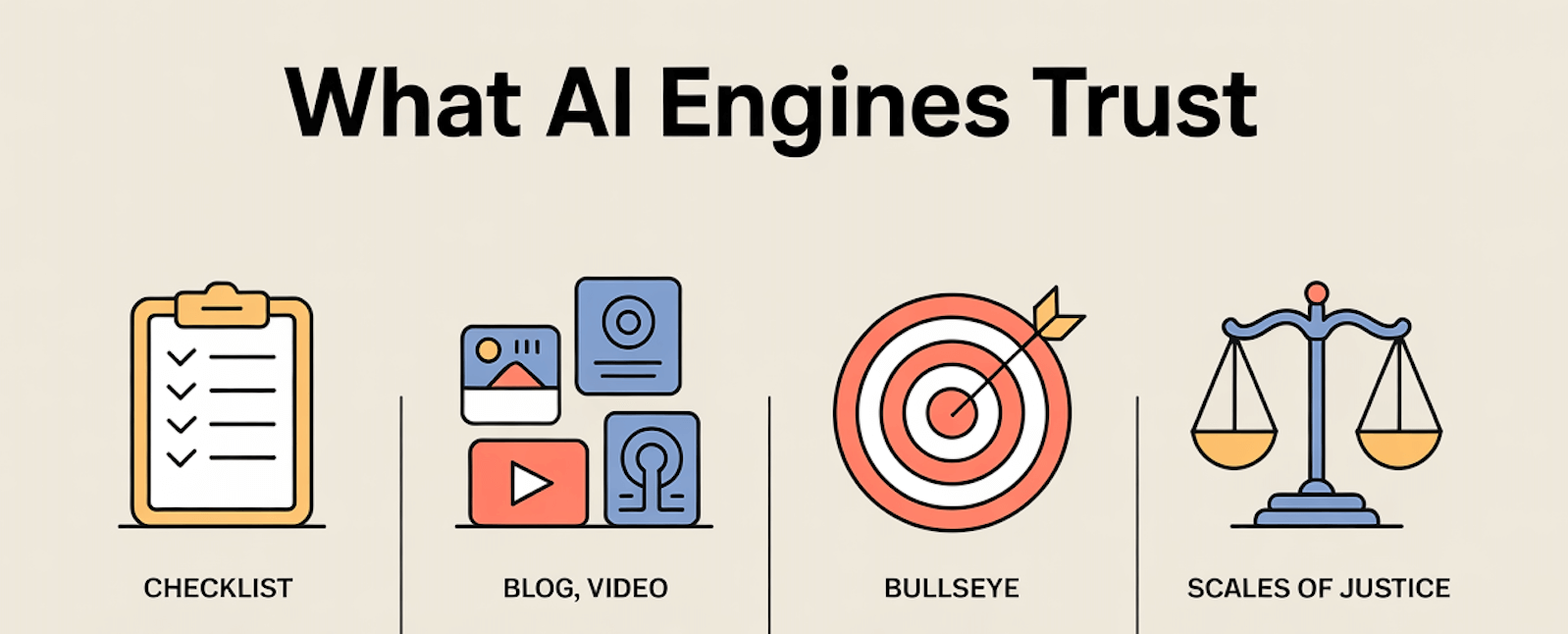
Looking at this list, the strategic imperative is clear. To win, you must produce a high volume of structured, multi-format, authoritative content. And in that sentence lies the new, crushing bottleneck for modern content teams. Creating one great blog post is hard enough. Creating a blog post, a video, a podcast, and a social media thread from that one idea, week after week, is a logistical impossibility for most.
Building Your GEO Content Engine: A Tool Stack Comparison
| Approach | Tools Required | Workflow Friction | Best For |
| The "All-in-One" Engine | Kukarella | Low. A single, integrated platform for script generation, voice cloning, and audio production. | Teams that need to produce a high volume of diverse, multi-format content with maximum speed and efficiency. |
| The "Manual Stack" | ChatGPT/Claude (for text) + A TTS/Cloning Tool (for voice) + A Video Editor (for video) | High. Requires constant copy-pasting between multiple disconnected tools and subscriptions. | Tech-savvy solo creators or specialists who want to use the "best-in-class" tool for each individual step and are comfortable managing the complex workflow. |
The GEO Content Engine: A Playbook for Creating Citable Assets at Scale
This is where you shift from manual labor to a leveraged workflow. The following is a four-part playbook for using an integrated AI content platform like Kukarella to generate the exact assets LLMs are looking for, in a fraction of the time.
Tactic #1: Generate Citable "Answer" Content Instantly (The FAQ Engine)
The most fundamental way to get cited is to directly answer a question. FAQ-style content is the native language of LLMs.
- The LLM Need: Clear, direct answers to common user questions.
- The GEO Solution: Use Kukarella's AI Assistant to generate the foundational text for a high-value FAQ or "explainer" article in minutes.
- Action: Open the AI Assistant.
- Prompt Example: "Act as an expert in sustainable home living. Write a comprehensive guide titled 'The Beginner's Guide to Composting.' Structure it as an FAQ, covering topics like what can be composted, the difference between green and brown materials, common problems, and the benefits for a garden."
- The Result: You receive a detailed, well-structured article that serves as the perfect script. This isn't just a blog post; it's the raw material for your entire content campaign.
Tactic #2: Create "Citable Debates" for High-Consideration Topics
When users are making a purchasing decision, they ask the AI to compare options. Your brand needs to be part of that consideration set.
- The LLM Need: Content that fairly and authoritatively compares different products, strategies, or ideas.
- The GEO Solution: Use DialoguesAI to generate a nuanced, conversational script that explores multiple viewpoints. This is a far more engaging and citable format than a dry comparison table.
- Action: Open AI Assistant in DialoguesAI.
- Prompt Example: "Create a professional dialogue between two e-commerce consultants. One, named Sarah, argues that Shopify is the best platform for new businesses due to its ease of use. The other, named Tom, argues that WooCommerce offers better long-term flexibility and control. They should discuss pricing, scalability, and app ecosystems."
- The Result: You now have a script filled with quotable, expert-level soundbites. When an LLM processes a query like "Shopify vs. WooCommerce," it can pull direct quotes from your content, positioning you as an authority on the topic.
Tactic #3: Master the YouTube Transcript Strategy
This is one of the most powerful and overlooked GEO tactics. Backlinko's research is explicit: LLMs ingest and cite content from YouTube video transcripts and descriptions.
- The LLM Need: Video content backed by a complete, accurate, and keyword-rich text transcript.
- The GEO Solution: Execute a seamless "script-to-seeded-video" workflow.
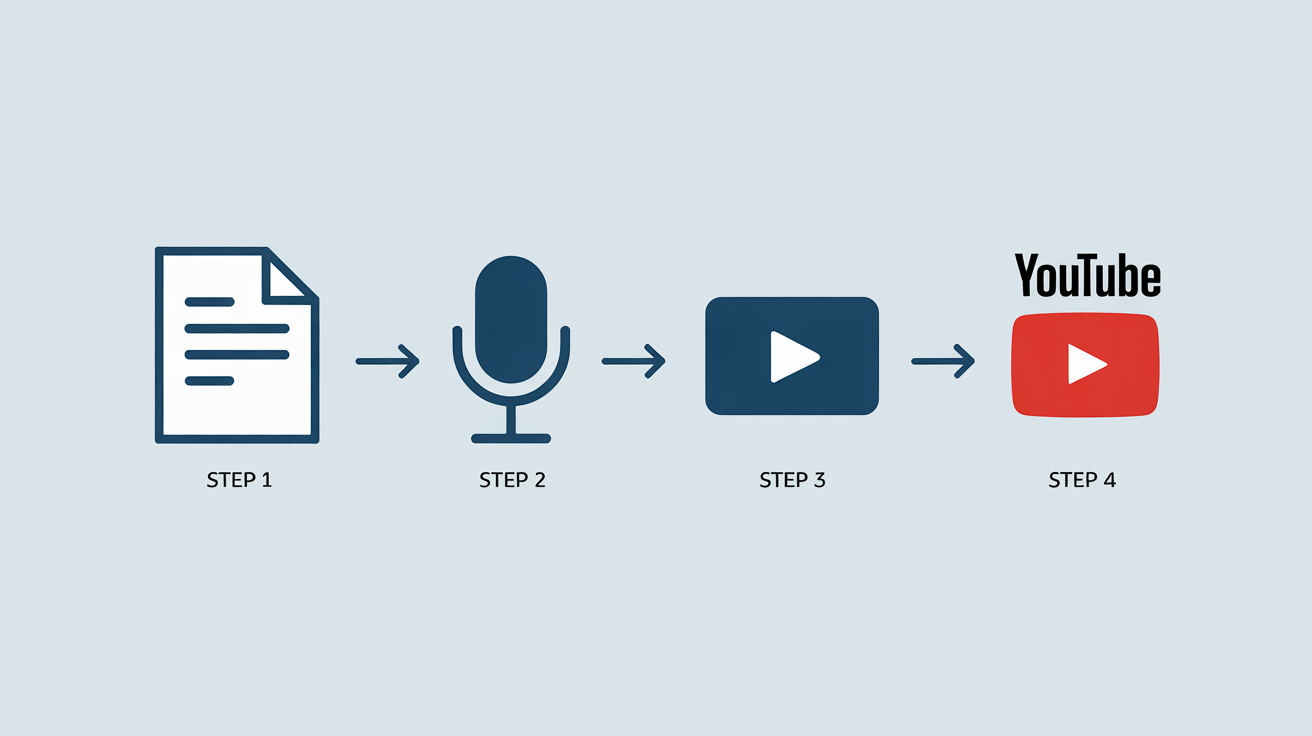
- Generate Your Script: Use the AI Assistant or DialoguesAI (as above) to create your expert content.
- Generate Your Voiceover: Use a professional, high-quality TTS voice. For maximum authority, use your own Custom Voice Clone. A consistent, human voice is a massive signal of quality.
- Produce Your Video: Pair the professional voiceover with simple visuals—stock footage, animated text, or a slide presentation.
- The Critical Step: When you upload to YouTube, copy the entire text script you generated and paste it directly into the YouTube description box.
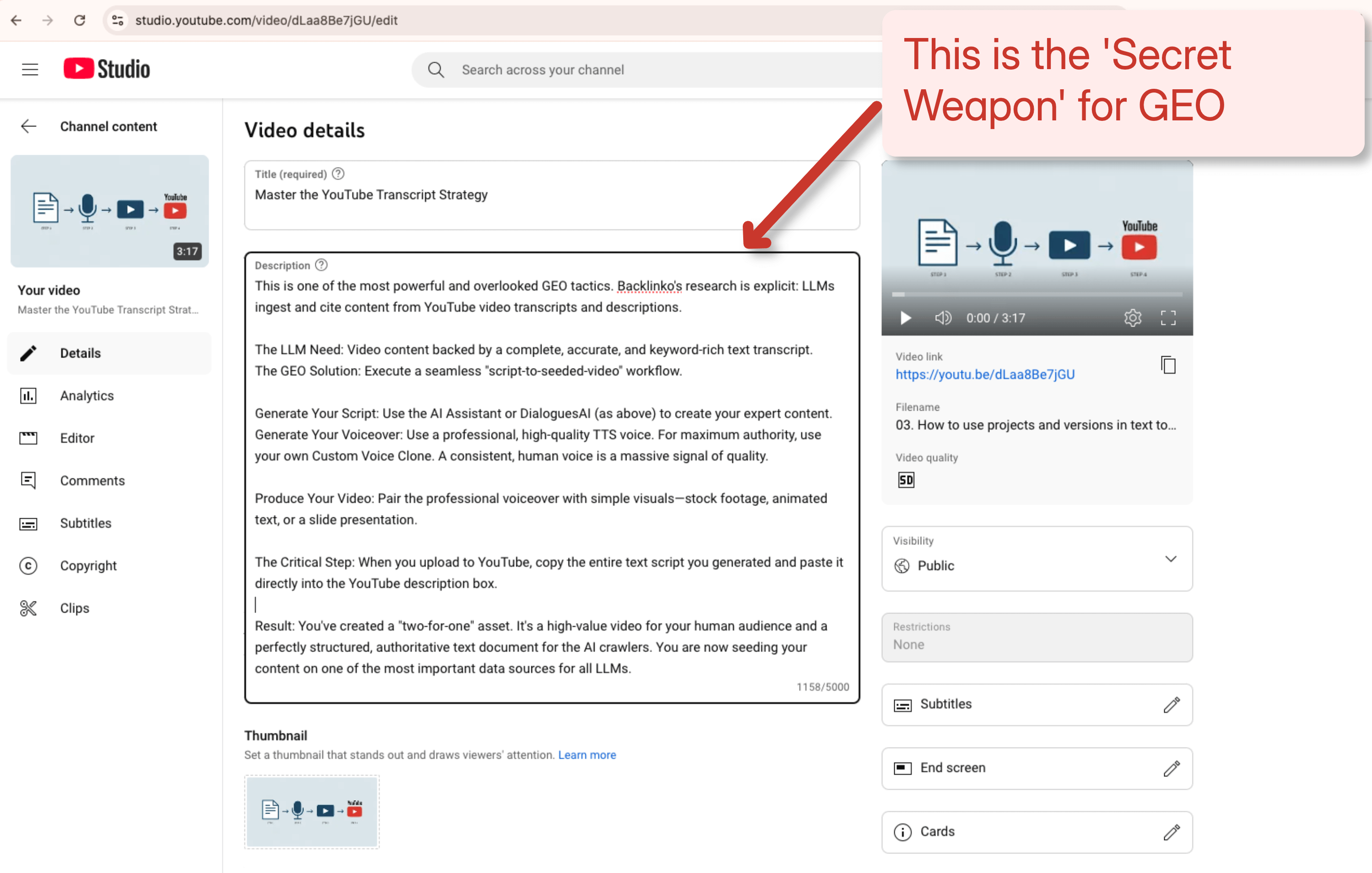 Screenshot of a YouTube video with the full, word-for-word script pasted into the description box for AI crawlers to index
Screenshot of a YouTube video with the full, word-for-word script pasted into the description box for AI crawlers to index- Result: You've created a "two-for-one" asset. It's a high-value video for your human audience and a perfectly structured, authoritative text document for the AI crawlers. You are now seeding your content on one of the most important data sources for all LLMs.
Tactic #4: Build "Sonic Trust" with Your Unique Voice
The end goal of a citation is to create a human connection. When the AI mentions you, a real person becomes aware of your brand. Your next job is to earn their trust.
- The LLM Need: To cite sources that demonstrate strong E-E-A-T (Expertise, Experience, Authoritativeness, Trustworthiness).
- The GEO Solution: Create a "Sonic E-E-A-T Signal" by using a single, consistent Custom Voice Clone across all your audio and video platforms.
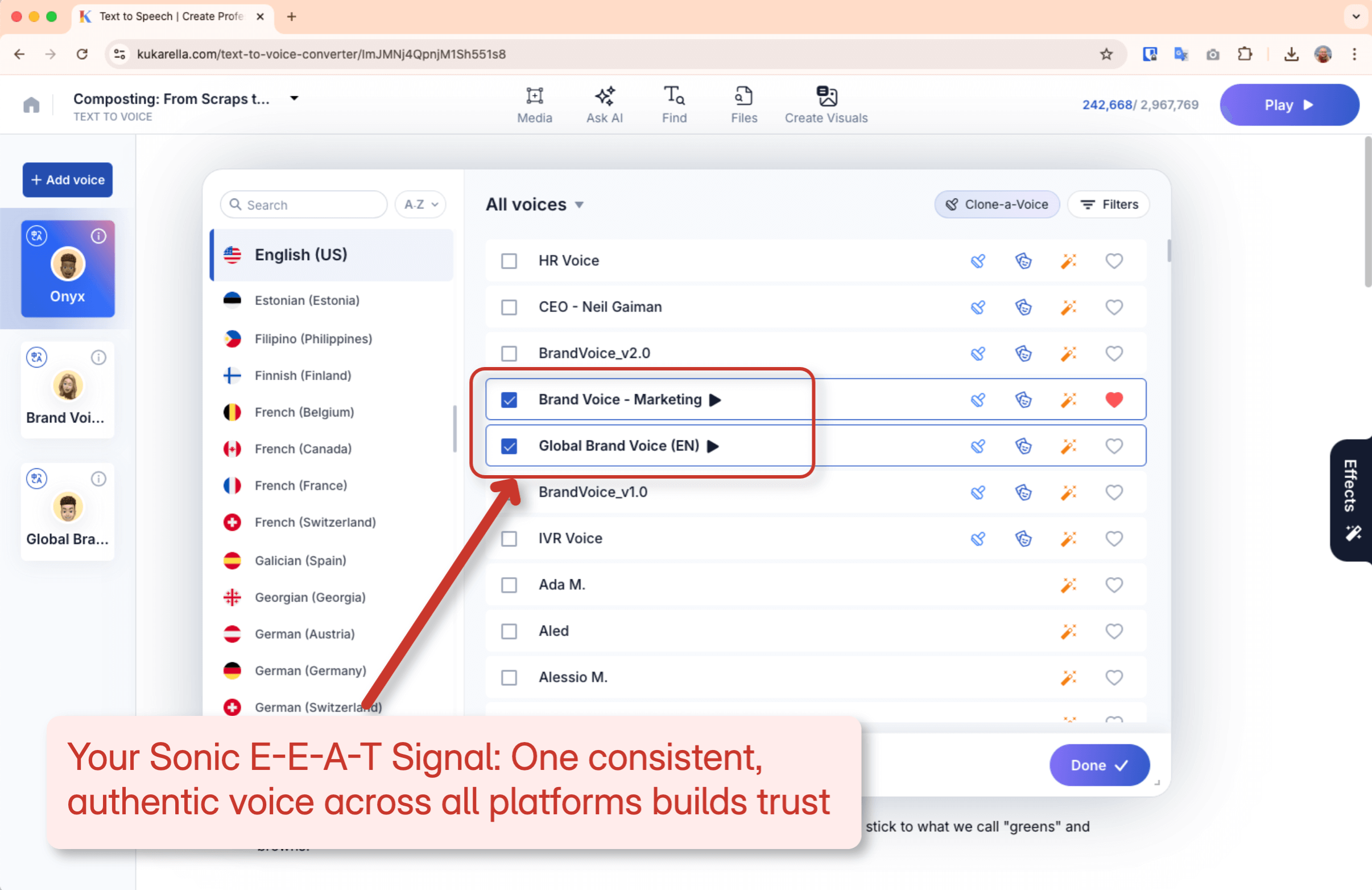
The "Plot Twist":
LLMs are forcing brands to become true multi-format publishers. A user who sees your brand cited in a ChatGPT answer may then discover your podcast, and then find your YouTube channel. When they hear the exact same voice—your authentic, consistent brand voice—on every platform, it creates a profound and subconscious signal of stability, professionalism, and trust. A fragmented sonic identity with different voices everywhere signals chaos. A unified sonic identity signals authority.
Where to Seed Your Content: The LLM Feeding Grounds
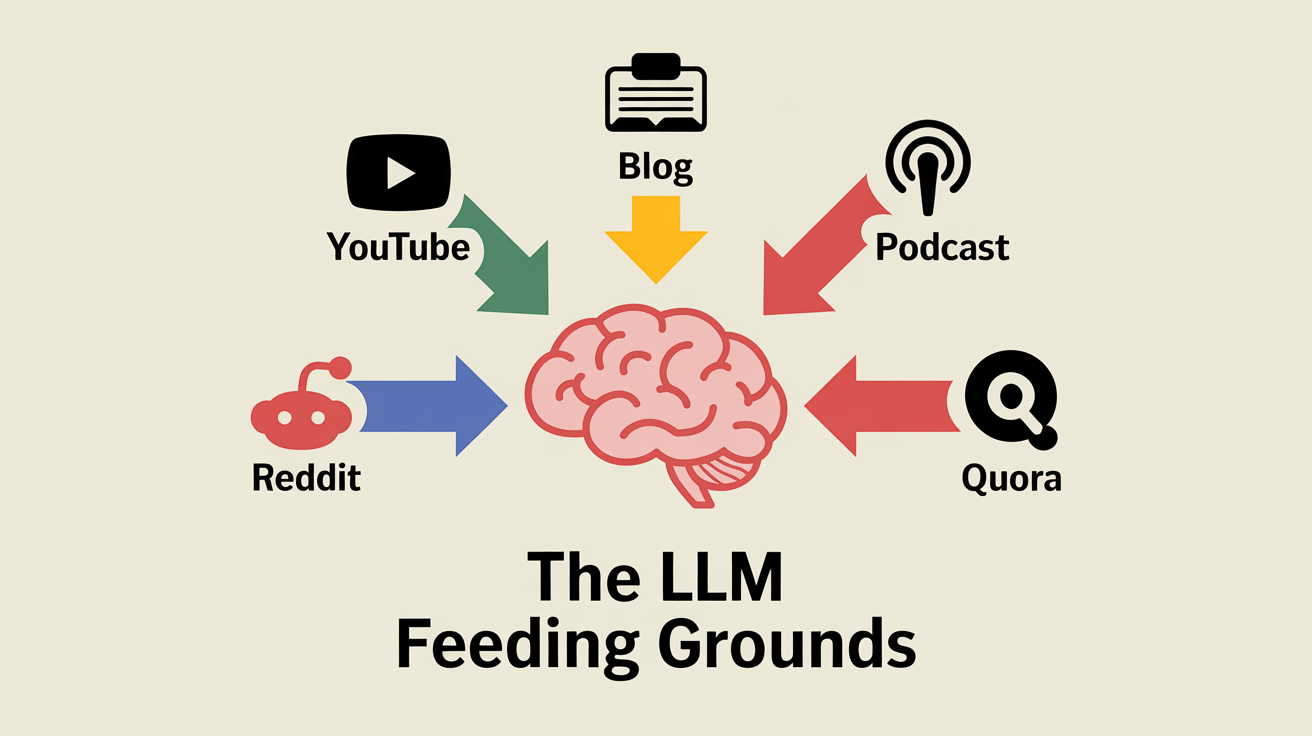 An infographic showing the key "LLM Feeding Grounds," with arrows from YouTube, blogs, podcasts, Reddit, and Quora all pointing to a central AI brain
An infographic showing the key "LLM Feeding Grounds," with arrows from YouTube, blogs, podcasts, Reddit, and Quora all pointing to a central AI brainCreating these assets is step one. Distributing them is step two. Your Kukarella-generated content (the text scripts and final audio files) should be published on these key platforms:
- YouTube: Your top priority. Every script becomes a video with a full transcript.
- Your Company Blog: The home base for your text content. Use structured data (like FAQPage and Article schema) to make your content even easier for AI to parse.
- Podcast Platforms: Every voiceover is a potential podcast episode. This places your brand in an entirely different discovery ecosystem.
- Community Hubs (Reddit & Quora): These platforms are direct pipelines into the LLM training process. Use your AI-generated scripts to help you write detailed, non-promotional, genuinely helpful answers to user questions. Then, link back to your full video or blog post as the source.
- Third-Party Publications (Guest Posts): Publishing on trusted industry sites provides high-authority citations that LLMs weigh heavily.
Measuring Success in a Zero-Click World: The New GEO Metrics
The old metrics are misleading. Clicks and sessions are vanity metrics in a world of AI answers. You need a new dashboard.
- Branded Search Growth (Google Search Console): This is your new North Star. As LLMs cite you, more people will search for "[Your Brand Name]" directly. This is the clearest signal that your visibility in the AI's "mind" is growing.
- Direct Traffic Growth (Google Analytics): A secondary signal of the same effect. People see your name, remember it, and type your URL directly into their browser.
- Manual Prompt Analysis: This is non-negotiable. Once a week, using a private browser, ask the top 10-15 questions in your niche to ChatGPT, Claude, and Perplexity.
- Is your brand mentioned?
- How is it mentioned? (As a top choice? A budget option?)
- Who is being mentioned? (Analyze their content format. Reverse-engineer their success.)
Track the results in a spreadsheet. This is your direct qualitative data on brand perception inside the AI.
Troubleshooting Your GEO Strategy
Q: "I'm creating the right content formats, but my competitor is still getting cited more."
A: You are likely losing on the E-E-A-T front. The LLM has determined your competitor is a more credible source.
- Solution: Double down on authority signals. Add author bios to your posts. Cite data and link to reputable sources. Most importantly, ensure your content has a unique, human-centric perspective. Use the AI to generate the structure, then use your own expertise to add stories, case studies, and personal insights that only you can provide.
Q: "This sounds like I'm just creating content for robots."
A: You are creating structured content for robots so that your unique, human message can be delivered to other humans. The structure gets you the citation. The quality of your message is what earns the trust of the person who sees the citation. You need both.
Q: "How can my small business possibly compete with a huge brand like HubSpot that can produce this much content?"
A: This is the beauty of GEO. The LLM does not care how big your company is. It cares about the quality and clarity of your answer. A small but expert-driven niche site that provides a perfectly structured, direct answer to a long-tail question can absolutely be cited over a large, generic corporate blog. Leverage your niche expertise. And leverage an AI content engine to match the output of a larger team.
The digital landscape has been reset. The brands that will win the next decade are not the ones with the highest SEO budget, but the ones with the most efficient engine for producing authoritative, multi-format content. The choice is simple: continue playing a game whose rules are expiring, or start building the content machine that will dominate the new era of search.
Invalid table data